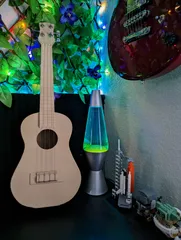Djembe
Description
PDFIntroduction
This design is a fully functional adult sized djembe. The design should be scalable up or down as long as you can source proper metal rings for the scale you bring it to.
Through a handful of iterations, this design has lead to a playable djembe that sounds good, plays loud, and has tonality that matches a medium to high quality wooden djembe.
Below you will find printing instructions for the files as well as a supply list. Videos on how to work with a goat skin, put together a proper djembe ring set, and string it all together are also included. I did not create those videos, but they are outstanding and extremely helpful when figuring out what is key and what is not in the assembly process.
Instructions
Print Settings | ||||
File | Layer Height | Infill Percentage | Walls | Supports & Orientation |
Top | 0.25mm | 10%* | 4-5 shells/walls/perimeters* | None, printed upright from bottom*** |
Middle | 0.25mm | 10%* | 4-5 shells/walls/perimeters* | Supports needed to prevent sagging along the overhang edge of the bottom ring catch, printed upright from bottom**** |
Bottom | 0.25mm | 10%* | 4-5 shells/walls/perimeters* | None, printed upright from bottom |
Logo (both P & K) | 0.25mm | 10% | 2-3 shells/walls/perimeters | None, printed back side of letter down, curved side up |
* Playing with the infill of the drum seems to produce unique variations in the sound produced by the instrument, which can lead to louder but tinnier sounds with less infill and more subdued and thicker sounds with more infill. The quality of the goat skin also changes the quality of the sound. ** This is a bare minimum setting, increasing this will only help stiffen the drum, albeit at the cost of print time. If you are printing with a rather bendy PLA blend or materials that are less stiff than PLA, I suggest increasing this to reduce any potential cracking or wear in the body once under full tension. *** I print on a large volume Rasie3D Pro3 and therefore the orientations of the body listed may not be suitable for folks with a smaller print volume. I am unsure if there is a way to effectively orient or split the body for printing on a smaller build platform. I am all ears for suggestions! **** Splitting this part in two is a possibility to reduce the need for support material, but it will decrease the strength of the drum as a whole. The tension from the strings would no longer hold the bottom half of the drum in place rather, just glue. Feel free to give it a shot and report back! I for one lean into my drum a bit and think I may shear it apart if I did not print this as one piece. | ||||
When it comes to pricing a djembe out one can go the Amazon.com route and get a good sounding instrument or one can go the more niche route and get an amazing instrument. I added a link to a more niche site to source materials from.
Parts List | ||||
Part | Image | Details | Link | Estimated Cost |
Goat Skin |  | I suggest purchasing a goat skin that is 20" in diameter or greater if this your first time building a djembe. The larger the more manageable and more forgiving the assembly process is. | https://www.amazon.com/gp/product/B07QHG1C3W/ref=ppx_yo_dt_b_search_asin_image?ie=UTF8&psc=1 | $35 |
Paracord |  | 750lb paracord will do, but 1000lb paracord is a better choice as it will stretch less under the tension it is under. | ~150ft needed | $20 |
Metal Rings |  | Aluminum rings is a wacky choice, but I promise it works. My avid drummer friends didn't even realize that I went with such a cheap option when they all played the drum. The only long term effect I have run into so far is a greater need to re-tighten the paracord. The cadence is increased by quite a bit compared to a drum constructed with steel rings. But to save some cash and get the rings in a hurry this is totally workable! | 12" Rings (2 rings needed) | $40 |
Non-Amazon.com route: https://www.goatskins.com/ | ||||
Assembly
To assemble your djembe, line up the square pegs in each print (bottom → middle → top) and add glue at each plane that touches. I suggest super glue but really any glue that doesn't eat through the filament will do.
While the glue dries, it is time to tie up your rope onto your rings. This site will show you all the necessary steps: http://www.african-music-safari.com/djembe-knots.html
Once the djembe is all glued together and your rings are tied, follow the steps in this playlist: https://www.youtube.com/playlist?list=PLF7E55EED0324474A
I believe the most applicable videos for this build are the following:
- #3 - soaking the goat skin
- #10-16 - installing goat skin, installing ropes, positioning goat skin, trimming goat skin, tightening ropes, tying end knot, & shaving or sanding goat skin
Final Thoughts
This is a really challenging build if you are unfamiliar with rope work. But it is accomplishable by anyone with just enough grit and determination and I promise the results are well worth it!
Tags
Model origin
The author marked this model as their own original creation.

